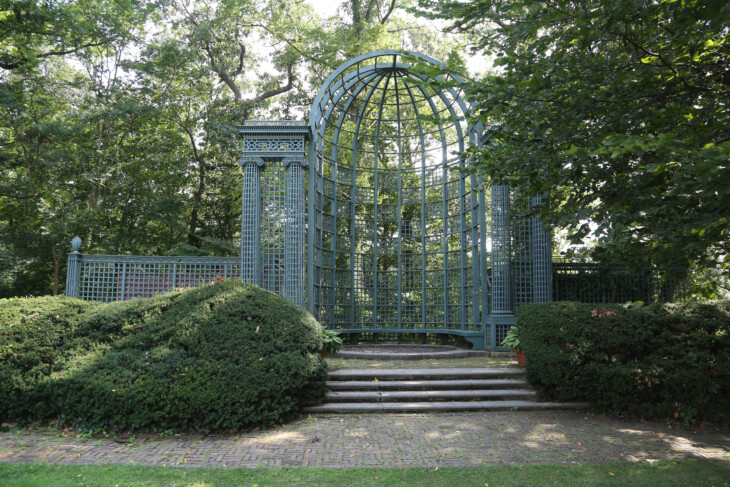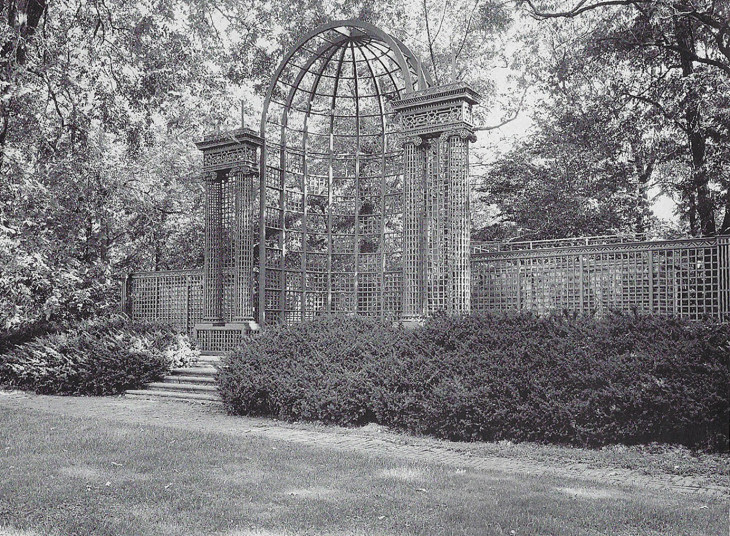Milliken-Bevin Trellis
1 Museum Drive, Roslyn Harbor
Project Files

Considered one of the most unusual examples of garden architecture in America, the Milliken-Bevin Trellis was designed by the architectural partnership of Henry O. Milliken and Newton P. Bevin in 1931.
Source: AIA Architectural Guide to Nassau and Suffolk Counties, Long Island-1992
__________________________________________________________________________________________
Bizarre '30's Trellis is Being Restored, New York Times, July 31,1988
LEAD: A CATHEDRAL-LIKE garden trellis of basketweave teak that soars to meet the tree tops on the grounds of the Nassau County Museum of Fine Arts in Roslyn has experts divided over its attractiveness.
A CATHEDRAL-LIKE garden trellis of basketweave teak that soars to meet the tree tops on the grounds of the Nassau County Museum of Fine Arts in Roslyn has experts divided over its attractiveness.
However, those with expertise in landscape architecture agree that the nearly 60-year-old trellis is well worth the $50,000 donated by the Roslyn Landmark Society for its yearlong restoration, which is expected to be completed next month.
''It's just a beautiful design,'' said Dr. Roger Gerry, president of the Roslyn Landmark Society, who, with his wife, Peggy, spurred the drive for the trellis's reworking.
''It's rather bizarre,'' said Valencia Libby, a professor of garden history at Temple University in Philadelphia.
Ms. Libby wrote an essay about the grounds at the former Childs Frick estate, where the trellis stands, for a 1985 Museum of Fine Arts exhibit entitled ''House and Garden.''
''I have never seen anything like it on that scale,'' she said. ''It's a recreation of classical architecture in trellis work, ''I would look at it today as a folly. I think they did it in all seriousness. It's a great joke.''
However, Ms. Libby agrees that the trellis, which, incidentally, was never meant to support vines, should be rescued. ''The bizarreness of it is why it's worth restoring,'' she said. Proportioned on a grand scale, the dome of the latticework trellis rises more than 30 feet into the air, where its apse is overlapped by surrounding yews. A temple among the trees, its main purpose was to provide a focal point for the formal boxwood and flower gardens designed by Marian Cruger Coffin.
Patterned after 18th-century French garden structures, the trellis owes much of its design to the neo- classical Hollywood taste of the 1930's, when it was built by the now- deceased New York architects Henry O. Milliken and Newton P. Bevin.
Their model of the trellis, part of the permanent collection of the Cooper-Hewitt Museum, is now on display at the Parish Art Museum in Southampton. According to David McFadden, a curator of decorative arts at Cooper-Hewitt, the general idea of trellises falls somewhere between nature and architecture.
''The idea of a structure in the garden is a very old one,'' he said. ''A trellis combines light and greenery in a very special way, It's an elegant refinement to the garden. It gives a center and focus, but doesn't destroy the expression of nature.''
The historical significance of the Milliken-Bevin trellis would seem in part to depend on its location. ''It was the center of a great American estate,'' Dr. Gerry said. The Fricks, who called the estate Clayton, purchased the 200-acre property in 1919 from Lloyd Bryce, then owner and editor of The North American Review.
Mr. Bryce commissioned the building of the estate's circa 1900 neo- Georgian house shortly after he acquired some of the land from William Cullen Bryant, the 19th-century poet and journalist.
Under the Fricks's ownership, the estate supported formal gardens, a pinetum of 450 varieties of conifers, five miles of bridle paths, wandering peacocks and an animal village, where large primates were caged.
Mr. Frick, a well-known paleontologist and a sponsor of the Museum of Natural History, was the son of Henry Clay Frick, a founder of the U.S. Steel Corporation whose house and collection comprise the basis of the Frick Collection.
Four years after Mr. Frick's death in 1969, Nassau County acquired 165 acres of Clayton and the house, now the headquarters of the county's Fine Arts Museum.
Although the Frick heirs removed a number of garden ornaments, including a large sundial once part of the trellis's overall design, nobody took away the gargantuan bower.
In fact, it would seem that nobody paid much attention to it at all, except for the Gerrys.
''It's been deteriorating for years and kept getting worse and worse,'' Dr. Gerry said. ''Fundamentally, our budget is not big enough to take on projects of this sort.''
But faced with the imminent possibility of the trellis's demise, brought on by the ravages of the elements, the Gerrys marshalled the forces of the Roslyn Historical Society and offered to restore the structure for the county.
''The chances of anything like it being created again are very slim,'' Dr. Gerry said. ''They are hard to make and expensive. Very few were made in the United States.'' How much did the trellis cost to build? ''Probably no more than what we're spending to restore it,'' Dr. Gerry said, About $33,000 already has been spent on replacing the trellis's teak slats and the brass pipe that supports its four Ionic columns. The work is being done by Wooden Bridge Inc. of Sea Cliff and paint analysis by Samuel Cabot Inc. of Boston. The actual painting is estimated to cost nearly $12,000.
''By July 31, we'll find out if we get a New York State grant,'' Dr. Gerry said.
The grant request was for $5,888. If denied, Dr. Gerry said, his organization ''will probably try to raise the money. We have about half now.''
After 12 gallons of acrylic latex green are washed over the structure, two decorative wings originally positioned on either side of the trellis's dome may be restored.
The wings depict an Arcadian scene nearly mirrored by reality on a recent morning, when an abundant number of cottontail rabbits and chipmunks busily hopped and scurried about before the trellis.

0 Comments